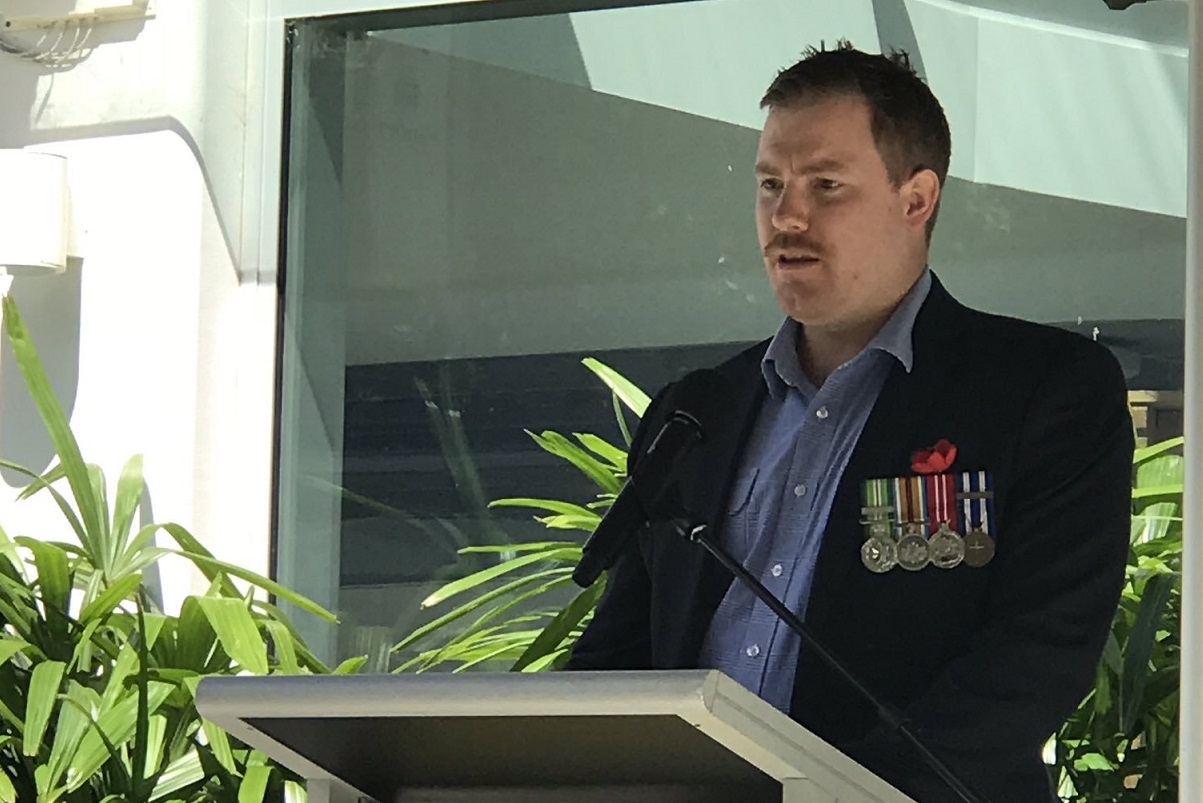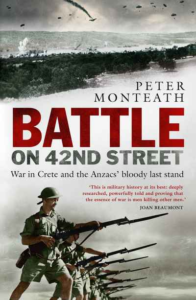
Flinders staff gathered to hear a commemorative address from Captain Brendan Hardman on Remembrance Day, 11 November, and witness the launch of the University’s new Military Academic Pathway Program.
Captain Hardman is Relationship Officer at the Hospital Research Foundation in Adelaide and spent several years in the army before spinal injuries forced his departure. He attended on behalf of Lt General and Professor Peter Leahy AC, Chair of the Australian Student Veterans Association, who had been scheduled to speak but was called away at the last minute.
Captain Hardman delivered a heartfelt account of managing his own mental and physical rehabilitation, focusing on three issues of paramount importance to him – purpose, service and education.
His situation underlined the importance of the new program that will help provide assistance for veterans to embrace fresh opportunities. A total of 24 students have enrolled in the inaugural four-week Military Academic Pathway Program that will start shortly.
Guests observed a minute’s silence to remember those who have lost their lives in wars or conflicts, before proceeding to FUMA (the Flinders University Museum of Art) for morning tea.
United in our respect of veterans

Flinders University had a visible presence at the Remembrance Day Round clash for the Hyundai A League at Hindmarsh Stadium on Sunday November 10. As Premier Partner of Adelaide United Football Club, Flinders’ brand is emblazoned on the front of team shirts – and a contingent of academic and research leaders were present at the game.
A minute’s silence was observed by the capacity crowd before kickoff, in a match that saw United win its second game of the season with a 1-0 victory over the Brisbane Roar.
Changing landscape of support and remembrance
Three Flinders University academics are leading discussions in Australia on how we support our returned service men and women – and how the nation remembers those who have fought for their country and the sacrifices made.
Professor Philip Payton released his new book More Than The Last Shilling: Repatriation in Australia 1994-2018 at a Department of Veterans’ Affairs lunch event in Canberra on 7 November.
 Timed to coincide with Remembrance Day commemorations, the volume is published by the Australian Government Department of Veteran Affairs, with ebook available from the University of Melbourne Press.
Timed to coincide with Remembrance Day commemorations, the volume is published by the Australian Government Department of Veteran Affairs, with ebook available from the University of Melbourne Press.
With a Foreword by Governor-General the Hon David Hurley, Professor Payton’s book delivers an account of repatriation in Australia, beginning in 1994 and ending in 2018 (which marked the centenary of repatriation).
In 1994 the Department of Veterans Affairs (DVA) was in the last phase of divesting its ‘Repat’ hospitals, as it evolved from being a major provider of medical care to a leading purchaser in response to perceived changing needs of its ‘ageing clientele’. The department took on new areas of rehabilitation and compensation, while recognising that a new wave of younger ex-service men and women were joining the ranks of older veterans, bringing with them new issues and expectations.
Professor Payton’s book explains the dynamic changes over a quarter-century, covering topics from the Vietnam War legacy, to the increasing (and sometimes controversial) prominence of commemoration in Department of Veteran Affairs’ activities.
Meanwhile, Flinders historian Dr Romain Fathi has suggested the absence of a public holiday on 11 November restricts the community’s ability to attend remembrance services.
In the newly published book The Great War: Aftermath and Commemoration, Dr Fathi outlines how excessive government spending on the glorification of Anzac Day on the former Western Front and in Gallipoli has overshadowed Remembrance Day.
“When the Shrine of Remembrance was dedicated in Melbourne in 1934, it included an aperture in its dome for a ray of sunlight to shine through on Remembrance Day, at the eleventh hour, of the eleventh day of the eleventh month,” Dr Fathi explains.
“This ray of light was the most striking commemorative feature of the building, and the day chosen by Australians back then to showcase this feature was Remembrance Day, not Anzac Day. The unveiling of the Shrine, on Remembrance Day 1934, was attended by 300,000 people. However, since the 2000s, crowds at official Remembrance Day state services in Australia have rarely exceeded a few hundred.”
He says that while Remembrance Day in 2018 marked the end of the centenary period, it attracted little public attention and questions its ability to ensure.
See Dr Fathi’s chapter in The Great War: Aftermath and Commemoration, edited by Carolyn Holbrook, Keir Reeves, UNSW Press, October 2019, https://www.newsouthbooks.com.au/books/great-war1/
Flinders University historian Professor Peter Monteath has issued a new book profiling some of the brutal realities that face Australian troops in battle.
 The Battle of Crete, one of the most spectacular military campaigns of World War II, is the subject of his book Battle on 42nd Street: War in Crete and the Anzacs’ bloody last stand.
The Battle of Crete, one of the most spectacular military campaigns of World War II, is the subject of his book Battle on 42nd Street: War in Crete and the Anzacs’ bloody last stand.
“On the occasion of Remembrance Day, we’re encouraged to think about men being sent abroad to die, but this book is largely about the other side of that equation – of men being asked to kill,” says Professor Monteath.
“At what point does the will to survive on the battlefield give way to bloodlust? How is it that ordinary men can be made into killers on the battlefield? These are important questions to ask within the context of armed combat.”
His book follows the course of events that led to that extraordinarily bloody battle, from the recreation of the Anzacs by teaming Australian and New Zealand infantry forces on mainland Greece, through their hammering from the skies by the Luftwaffe and their bitter but doomed efforts to hold the strategically vital points of Maleme and Galatas in Crete, and finally to the Battle on 42nd Street.
Professor Monteath’s new title has earned rich praise for its thoroughness and compelling storytelling from acclaimed Australian military historian Joan Beaumont, who says: “This is military history at its best: deeply researched, powerfully told and proving that the essence of war is men killing other men.”

